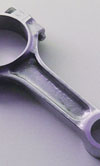Halted progress
 The article on Advanced Metals last month looked at some of the aluminium materials which are being used and investigated currently in Formula One. This month we shall begin to look at some of the applications of titanium alloys, again at which materials are currently being used, and what might be over the horizon.
The article on Advanced Metals last month looked at some of the aluminium materials which are being used and investigated currently in Formula One. This month we shall begin to look at some of the applications of titanium alloys, again at which materials are currently being used, and what might be over the horizon.
The main applications for titanium in racing engines currently are connecting rods, valves and fasteners. Indeed, there are a number of production engines where titanium is now the material of choice for connecting rods and valves. Whilst the first production engine use of titanium was on motorcycles in 1988 (on the Honda VFR750R), the high-profile introduction of this to road-cars followed shortly afterwards, again by Honda with their NSX sports car. More recently the Corvette has followed this trend with the Z06 using titanium con rods.
If we restrict ourselves to pure racing engines, by far the most popular material for con rods is Ti-6Al-4V, an alloy containing, as one might reasonably expect, 6% of aluminium and 4% of vanadium. This is the predominant material for all uses available on the world market – it is produced by many of the leading materials producers and by dint of the amount of material produced is relatively reasonably priced. It can be heat-treated to high levels of strength and is generally of a high quality, although I have seen absolutely appalling quality material in this grade – beware those offering bargain-basement prices for titanium if you are unable to check the quality of the bar-stock beforehand.
Besides Ti-6Al-4V (also known as Grade 5 Ti or TA46), there have been various grades examined for con rods. The beta forging alloys have been used for forged titanium racing rods, particularly Ti-550 and Ti-551. Both of these alloys have additions of Aluminium, Molybdenum, Tin and Silicon, with 551 being more highly alloyed and offering higher room temperature strength. However, after speaking to a number of well-known con rod manufacturers, it seems that a lot titanium con rods are no longer made from forgings, but from blanks made from wrought materials (plate in particular).
As far as alternatives are concerned, there are a few materials which look promising, and some more that are being developed for use as racing rods. Some of the less common materials look to have excellent mechanical properties and good fatigue behaviour. However, unless there can be guaranteed continuity of supply and quality, people are either forced to stick with Ti-6Al-4V or to purchase sufficient quantities of the material to cope with fluctuations in the supply of the raw materials.
Perhaps where the rules allow it, the titanium aluminide materials would be a good replacement for the conventional titanium materials. It has been confirmed to me that this material has indeed been used successfully for con rods in racing applications, although, in this particular application, it has been shelved owing to high material costs.
It is outlawed in Formula One, under regulation 5.13.1: Unless explicitly permitted for a specific engine component, the following materials may not be used anywhere on the engine :
a) Magnesium based alloys ;
b) Metal Matrix Composites (MMC’s) ;
c) Intermetallic materials ;
d) Alloys containing more than 5% by weight of Beryllium, Iridium or Rhenium.
Where intermetallic materials are defined by regulation 5.12.3: Intermetallic Materials (e.g. TiAl, NiAl, FeAl, Cu3Au, NiCo) – These are materials where the material is based upon intermetallic phases, i.e. the matrix of the material consists of greater then 50%v/v intermetallic phase(s).
There have been development efforts by a number of Formula One engine manufacturers in the direction of increasing the proportion of titanium aluminide to bring it close to this 50% limit – another example of the Formula One rules not working as intended. As with titanium now finding its way into production engines, it may be that, in years to come, titanium aluminide will become the material of choice. Rules which ban it simply stifle development of racing and production car engines. If you have open rules, the expenditure will be self-governing, with the titanium aluminide rod application as an exemplar.
MMC titanium alloys have also been developed for motorsport applications with additions of ceramic particles for additional stiffness.
Written by Wayne Ward.